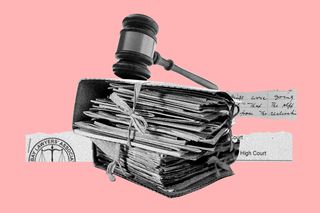
Work, Re‑cultured: A 24‑Year‑Old Lawyer Struggles With Virtual Hearings
“[Judges] use the free version of Zoom so the call drops after 45 minutes.”

In Work, Re-cultured, The Swaddle brings you a snapshot of what work-from-home culture looks like for Indian professionals across industries. First up, a 24-year-old lawyer, S.
I am an advocate, so I would say a substantial part of my work was going to various courts in Bangalore. This has been limited to virtual hearings for the past few months. Initially, a routine was hard to establish and there were definitely very frustrating days as our access to books, case files and clients became difficult. But for the past two months, we are back to somewhat normal functioning.
My work significantly reduced in the first phase of lockdown, too, so it was definitely easier to work from home. It has its benefits — especially having to not be on my feet for more than six hours during periods, and having constant access to snacks.
Before the pandemic, my average day looked like going to the office in the morning between 9 a.m. and 10 a.m., then to the courts until 3 p.m., and then drafting, research and briefing until 8 to 9 p.m. I wasted about three hours daily in commuting to various places for work. Now, I mainly do the latter for a majority of my workload, unless I have virtual hearings and then I prepare for them. But the caseload has reduced because not many new matters are coming up. Additionally, due to the limited functioning of the courts, very few cases are being heard.
Related on The Swaddle:
Has Lockdown Made Us Reconsider the Work-From-Home Fantasy?
High Courts adapted in a much better way to hearing vis-a-vis district courts. Infrastructure is still very poor and the requirement of filing hard copies in the court requires some of us to go to the office and court. It’s quite difficult. Internet facilities aren’t the best in district courts and most of the judges are having a hard time adjusting. Also, they use the free version of Zoom so the call drops after 45 minutes. It’s routine for the judge’s chamber to have a bad connection, which is creating a big difficulty. They also don’t have access to digital files. But I believe judges are doing their best to hear matters with the limited IT support they have in courts. It’s commendable that they are still going to courts daily.
Also, usually for a hearing, the briefing counsel, which is me, and the arguing counsel, usually a senior advocate, have at least two meetings to go over the case. However, now everything is over voice calls and emails. In High Court, unless a date is fixed, you will only know a case is listed tomorrow by the evening before, which just creates more difficulty as no one can be expected to keep all the case files for active matters at home. You will be surprised to know how traditional litigation offices still work, from using hard copies for everything to not having digital copies of even the important documents.
It’s not sustainable as it exists right now. Investment is required into IT infrastructure and training of both the judicial staff and officers. The Supreme Court is moving towards a move sustainable model, making everything from filing to hearings digital and quite accessible. I think the same model should be replicated all over the country.
As told to Rajvi Desai.
Related


Woe Is Me! “Why Do I Cry When People Show Concern For Me?”
